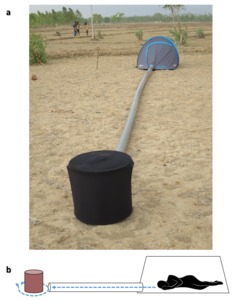Exploiting Anopheles responses to thermal, odour and visual stimuli to improve surveillance and control of malaria
Hawkes, Frances M. 
Preview |
PDF (Publisher's PDF - Open Access)
18227 HAWKES_Exploiting_Anopheles_Responses_(OA)_2017.pdf - Published Version Available under License Creative Commons Attribution. Download (1MB) | Preview |
Preview |
PDF (Author Accepted Manuscript)
18227 HAWKES_Anopheles_Responses_to_Thermal_Odour_and_Visual_Stimuli_2017.pdf - Accepted Version Available under License Creative Commons Attribution. Download (497kB) | Preview |
![Figure 1 [thumbnail of Figure 1]](https://gala.gre.ac.uk/18227/20.hassmallThumbnailVersion/18227%20HAWKES_Figure_1_2017.png)  Preview |
Image (PNG) (Figure 1)
18227 HAWKES_Figure_1_2017.png - Accepted Version Download (496kB) | Preview |
![Figure 2 [thumbnail of Figure 2]](https://gala.gre.ac.uk/18227/21.hassmallThumbnailVersion/18227%20HAWKES_Figure_2_2017.png)  Preview |
Image (PNG) (Figure 2)
18227 HAWKES_Figure_2_2017.png - Accepted Version Download (3MB) | Preview |
![Figure 3 [thumbnail of Figure 3]](https://gala.gre.ac.uk/18227/22.hassmallThumbnailVersion/18227%20HAWKES_Figure_3_2017.png)  Preview |
Image (PNG) (Figure 3)
18227 HAWKES_Figure_3_2017.png - Accepted Version Download (81kB) | Preview |
Abstract
Mosquito surveillance and control are at the heart of efforts to eliminate malaria, however, there remain significant gaps in our understanding of mosquito behaviour that impede innovation. We hypothesised that a combination of human-associated stimuli could be used to attract and kill malaria vectors more successfully than individual stimuli, and at least as well as a real human. To test this in the field, we quantified Anopheles responses to olfactory, visual and thermal stimuli in Burkina Faso using a simple adhesive trap. Traps baited with human odour plus high contrast visual stimuli caught more Anopheles than traps with odour alone, showing that despite their nocturnal habit, malaria vectors make use of visual cues in host-seeking. The best performing traps, however, combined odour and visual stimuli with a thermal signature in the range equivalent to human body temperature. When tested against a human landing catch during peak mosquito abundance, this “host decoy” trap caught nearly ten times the number of Anopheles mosquitoes caught by a human collector. Exploiting the behavioural responses of mosquitoes to the entire suite of host stimuli promises to revolutionise vector surveillance and provide new paradigms in disease control.
| Item Type: | Article |
|---|---|
| Additional Information: | © The Author(s) 2017. Open Access This article is licensed under a Creative Commons Attribution 4.0 International License, which permits use, sharing, adaptation, distribution and reproduction in any medium or format, as long as you give appropriate credit to the original author(s) and the source, provide a link to the Creative Commons license, and indicate if changes were made. The images or other third party material in this article are included in the article’s Creative Commons license, unless indicated otherwise in a credit line to the material. If material is not included in the article’s Creative Commons license and your intended use is not permitted by statutory regulation or exceeds the permitted use, you will need to obtain permission directly from the copyright holder. To view a copy of this license, visit http://creativecommons.org/licenses/by/4.0/. |
| Uncontrolled Keywords: | Anopheles gambiae; Malaria; Mosquito control; Mosquito sampling; Mosquito behaviour |
| Subjects: | S Agriculture > S Agriculture (General) |
| Faculty / School / Research Centre / Research Group: | Faculty of Engineering & Science Faculty of Engineering & Science > Natural Resources Institute Faculty of Engineering & Science > Natural Resources Institute > Agriculture, Health & Environment Department Faculty of Engineering & Science > Natural Resources Institute > Pest Behaviour Research Group |
| Last Modified: | 27 Apr 2020 15:51 |
| URI: | http://gala.gre.ac.uk/id/eprint/18227 |
Actions (login required)
 |
View Item |
Downloads
Downloads per month over past year
 Tools
Tools Tools
Tools